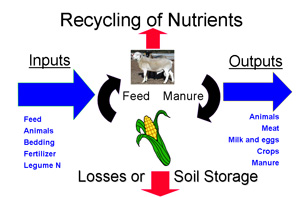An animal waste management plan consists of information about manure production, storage, and use. Manure can be disposed off site. All manure remaining on the farm should be spread according to a plan that distributes nutrients in manure on land according to the uptake rate of the various crops or grasses on the farm.
All animals and plants need nitrogen (N) and phosphorus (P), but when manure is not well managed these nutrients can degrade water quality.

Livestock and poultry farmers must maintain a balance between the nitrogen and phosphorus arriving and leaving the farm. These nutrients are contained in feed and fertilizer and leave the farm in animals, animal products, crops, and animal waste. If more nitrogen and phosphorus arrive on the farm than leave it, these nutrients accumulate in the soil. The potential for water quality degradation increases if these nutrients are carried away by storm water into streams and pond or seep into water wells.
To develop an Animal Waste Management Plan (AWMP) to meet the State requirement, use the resources in the book On-Farm Strategies to Protect Water Quality. This book will tell you how to prepare a paper copy of your AWMP.

